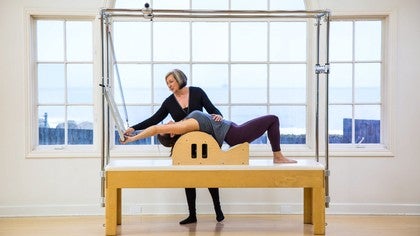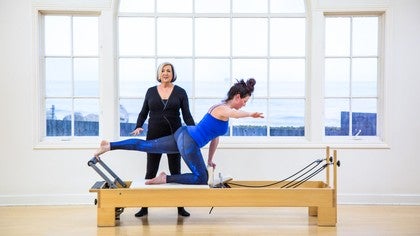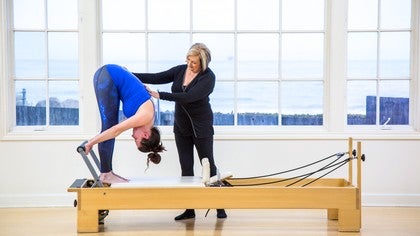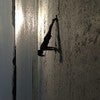Description
About This Video
Transcript
Read Full Transcript
Hi, I'm Cathy Corey and I'm here with Sarah today and we're going to be doing the high bridge. There were many steps in components to getting into the advanced exercises as Mr [inaudible] taught them, and one of the principles of the work is to really know the essence of Pele's in order to progress into the super advanced exercises. So the hybrid is done on the reformer as you know, but today we're going to start with our preparations on the one two chair. This is going to show us about spinal articulation control through the entire body as well as our foot placement. All of these things are absolutely necessary when we're working on the Highbridge. So Sarah, go ahead and lie down and let's test the spring for you.
We have it on one heavy spring and it's all the way up on the top in position and then in the high position. So it's going to be fairly heavy for you and just go ahead and press it down and back up. Is that good or is that too much? Now what I'd like you to do is press it down. Now what I want, how we adjust her position is once she's in the down position, we want to make sure that the feet are not too close to her hips, which we'll throw the pelvis off or too far away, which will tip it away. So we, I'll have her come up and down just two or three times and just as you're doing and come back down and once again, come on up now. Ha. How is the spring tension? Do you want me to take it down for you a little bit? No, it's good.
And so what we want to look at here is that long lines. So she's opening the hip flexors and we're going to watch the feet position as she comes through. Now we're going to have you roll down articulating one vertebra at a time. Now let's go ahead and watch how the feet arm. We want the foot to be racked over the pedal so that the metatarsal arch is really at the strongest place. When we get onto the reformer.
This is extremely important that we're not rolling in or out, but we're keeping that kinetic chain all the way from the foot through the ankle and up through the body. So let's go ahead and have you just lift and lower the legs three times. Good and really stretch it away from you and now press it down. We're looking at the position of the foot, the position of the knee, and the position of the pelvis so that what we want to be doing is making sure that the foot alignment stays in the correct position all the way through the movement. Now coming down in the down position, let's go ahead and do the bridge. This is a spinal articulation from the tailbone all the way up and not stopping at the shoulders, but lengthening through the neck and really pressing the head lightly into the, into the floor. Now from there, we're going to start by opening the throat after that and begin to lengthen the neck and come down one vertebra at a time.
Beautiful position all the way down and then stretch with the tailbone towards your heels and a full breath to come up. Yes, it is difficult to maintain because the spring does want to push you up so the whole body has to be working all the way through the movement and if you relax for just a minute and are not completely conscious of the movement, the spring is going to push you up. This is very important for when we get into doing the more advanced movements. As we get onto the reformer and come down now a bit more advanced, we're going to allow the pedal to come up. We're going to watch the foot position and from there we're going to roll up. Now here, if in fact you push down with your size, the pedal is going to push down, so it really has to be coming from the core muscles and once again we started the throat and we begin to roll all the way down, all the way down and reach with that tailbone. So it's full articulation, very nice. Two more of these.
Breathe and roll this spine up one vertebra at a time and come once again from the throat and roll it down. Ruling to come down. And one more time. Watch the foot position. Watch the alignment and coming up. Rolling. Getting full articulation of the spine, opening the front of the throat and rural and come all the way down.
And just place the feet on the floor for a moment. Good. And from there, just roll the everbody. So now we're just going to lift the upper body upward. [inaudible] very nice. So we're just getting it. Nice stretch just to that point. And roll down. Okay. So now we want to get the articulation through the upper body as we go as well. And now we're going to do one more exercise by placing the feedback on the bar.
And we're gonna roll this mine up. And now this is very, very difficult because it is a coordination through the whole body. And we're gonna press the pedal down and en up. Good three times, only down as far as you can without losing the energy all the way through the body without losing that energy. And come up and roll all the way down. So this is a great exercise and it's not a very easy either, but it's a super prep for where we're going to go into the Highbridge.
Thanks Sarah. As you can see, we've moved into the Cadillac exercises because once again, we want to look at how all of the exercises relate to one another in the [inaudible] method that w if you can do the Para parakeet and the back bend on the Cadillac, it's going to help us to do the Highbridge on the reformer. So the idea here is to start thinking about the essence, the essential movements that are in all of our exercises. So we build upon and progress through the exercises in order to move into the super advanced category. So we're going to start Sarah, by lying down, and we're going to start with the parakeet. One of my favorite exercises. Now we place the foot, and now usually I like to place my foot a little bit higher, right on the metatarsal arch. But for this exercise today, in order for us to think about the relationship of this and Highbridge, I'm going to have Sarah just go a little bit lower so that she is under the metatarsal arch and on the more in the center of the foot and we're having one red spring for her as well. Now from here, once again we want the body position to be so that she's going to extend the legs nice and long as she goes out. We're watching the foot position and alignment and we're going to bend in and right from here keeping the tailbone down.
We're going to stretch so that the legs go high to the ceiling. Good and we're going to bend the knees into the chest and we're going to stretch to take the legs out. Once again, one more of these just in what we're doing here is just testing how the feet are in relationship to the pelvis and the alignment and then back in and extend to go out. This time we're going to have her bend in. Thank you Sarah, and now she's going to just bring the legs up. Pelvis is still down. Now it's spinal articulation starting at the tailbone, beginning to roll the spine up, one vertebra at a time into this a long gated position. So we're opening that hip flexor. The back is nice and long. Now once again, as we did on the wonder chair, we're going to open from the throat and really get a nice long stretch all the way down, reaching with the pelvis. Then we bend the knees. I only come back out. There you go.
Good. Do you need to adjust your feet or you good? Sometimes when they're, sometimes they get slippery and okay and in and now the articulation of the spine to go up. Beautiful. And the roll from the throat all the way through. So we're getting a full articulation of the spine and the complete movement. Good. And now we'll add the leg walks to the next movement. We're going to keep the tailbone down. We'll borrow the spine to come up.
Now we don't change the pelvis, we keep it absolutely still and stable. So there's no shifting as one leg comes off and walks back. So we're stretching the hamstring now. So that we're going to relate this to the Highbridge with that single leg left. One more each side. Beautiful.
And last one. Good. When we're watching the stabilization of the hips in this position and once again we get that roll down from the throat and going all the way through and pressing out now. Well the next thing we're going to do is we're going to really put this together so that we're going to bend the knees. But now once we get to this position, as the legs go up, this body rolls up as well. So it is really a full articulation up with control. And then once again, now we start down both the body and the knees come in together and pressed to go out two more times we will in, that's it.
And articulate all the way up and roll the spine are rolling down and stretching all the way out. Last one, rural and stretched to come up.
And once again, we're looking at spinal articulation here. We're going to have you rural back, keeping the arms straight, rounding into flection. From there, the movement pushes through with the arms straight. Very nice.
Either way is fine with me. Yes, I think this is good. So when we have the feet against the Poles, we want to make sure, once again we're in the foot centers that if foot doesn't roll in or out, once again, this is very, very important as to what we are doing as far as the movement. Um, in the uh, Highbridge on when we are on the reformer. From there we're going to begin this articulation from the tailbone and rural. Okay. Either foot position is fine and continue to roll.
And when looking at this nice arch through the back and coming lifting up just a little bit more. There you go. Now as we come down, we're going to bring the throat they had in rolling down once again from the throat all the way through and rural, straighten the legs and sit up, push and come up. So you can see we're getting all that spinal articulation, which we really need when we are doing the high bridge on the reformer as well. Let's just do one more of these. Warming up the spine from that flection position with the arms nice and long and straight. Beautiful. And then we'd come back, keeping the arms straight. Really get that long stretch here. Bend the knees, roll it down, and come up, articulate the spine and lift and come down.
Bend the knees and bring the head in and rurals through the spine ruling to sit up nice and tall so we can see now she's really warmed up her back. And so the next thing we want to do is not only add the movement from the spinal articulation, but we need some power through the upper body as well. So we're going to go into the hanging position on the Cadillac. Let's take the spring down and waiting to put the trophies up. The hanging exercises are part of our traditional Cadillac work.
And I find once again, relating this work into the reformer Highbridge or and or other exercises that we are doing is very, very important. So what we want to do here is we're going to go into the traditional hanging movements and then we're going to add a leg extension to it. So let's begin placing the feet here. Hands on, on the bar. And from there, now we flips. If he'd around and really drop the tailbone. So we're getting this long stretch on the spine.
So important and it feels really good. Now from there we're going to lift through the pelvis and go into our plank position from the plank we live from the hips when we take the movement all the way up and allow the the head just to relax back into that arch. Come back into your plank and once again we're going to drop the hips down. Do you [inaudible] and get that long, long stretch on the spine, up to the plank position. One more time. From that plank we're going to lift so it's high into that beautiful long arch and come back into your plank and drop back down, flips those feet, grab onto the bars and really get that long spine stretch.
Beautiful. Go ahead and step off for a moment and just kneel down. Now what we want to do next is we're going to do that leg extension so that when we are going onto that high bridge and we want that leg to come in and up with the back arching on the reformer, we have that same kind of feeling with the body into a nice back bed, a long extension, but a single leg coming up as well. Are you ready? Yes. Okay. One, two another. This time if you go in the center.
When you take one leg in extended. Hi. Good. Now let the Lego high to the ceiling as we are chit you come up good. Come back to the plank position. Bend and reach out or their side comes in and up and lengthen from the hips. Hips are level as we go all the way up and come back. Bend, extend your up, back down and feet come off and step down.
Beautiful. Great. And it feels good. It's really, really nice and that will continue. We'll continue without the a tower so that we're going to move on to the spine corrector. On the Cadillac so that uh, we're going to once again open the chest continuing exercises for the Highbridge. We've placed the spine corrector on to the Cadillac so that we once again are going to continue the progression of exercises reaching into the high bridge is we know for the hybrid you really need to have a full opening of the chest and you have to have power through the upper body as well. So in training the muscles, we're going to do an exercise. We have one red spring on. This may be heavy for some people, so you might want to go to a lighter spring.
It can also be done with no spring. For someone who you just would like to get the chest to open a little bit more. So I'm gonna have you sit here on the spine corrector and what, I'm going to have you two slides forward just a little bit. So as you begin to roll back, I want the shoulders more on the top of the spine corrector good so that the neck and the head are completely supported in this movement. In this position, you should be able to reach the bar on your own so that if in fact the arms are bent when you reached the bar, you may be too close underneath it. If the, if you can't reach the bar, you're too far away. So once again, there will be space here, um, from the um, the tailbone and the low back if you need to. You could put a pillow or a towel or something there to support.
So now what we're looking for here is the bend of the arms and the prs to come back, bend the arms and keeping the body stable, reached to come back up and bend the arms, use your breath and exhale to take it all the way out. Good and bend. And the bar comes all the way up. Now we're going to bend and we're going to press it out. And this time it's just bend straight. And so you're going to bend and push. And I want that a longer duration shoulder.
Stay down and really use the spine corrector for the upper back and use the breath for the movement two more times. And lengthen it and pull the bar over the head and lengthen. This time the bar is going to come in and as the bar goes up, the body is going to come up and press into the spine corrector now by he comes down, roll it, bend the arms and push all the way out. Beautiful. And then come in. We have two of these left to do. Use the upper body press in strength and good, good, good.
And one more time. All the way down. All the way out and in and and now at this point this spring should be released so the arms can stretch back and then come under the bar and roll to sit up. I'm going to take the spring down. So we are now ready to do our first hybrid, not on the reformer but here on the spine corrector. Are you ready, Sarah? Okay, so we're going to roll the spine back
To come back up, press into the spine corrector. You need to really use the spine corrector as your warm up. One more time, roll it back, arms, go back, place them down and use the spine corrector. Press in, close the ribs and really stretch all the way up. Beautiful. Now this time you're going to roll back and place the hands down and now you're going to turn the hands over so they're there. They're in the position for your Highbridge and step one foot up.
Step the other foot. Now from there pressing into the spine corrector, you're going to articulate the spine and just roll off of it just so good and down an axial and roll up slightly and down. Now we're going to transfer that all the way into the upper body and for us and come off, straighten the arms and come up into your high bridge. Absolutely wonderful and come down beautiful and match the spine corrector and rural and one more time coming up. Rolling. Beautiful. This is very difficult. Now if you can, one leg is going to come up and extended and bend it and down other leg is going to come up and extend and bend it and come down. And now once again matched down, rule yourself down, Felice to set your body on the spine corrector, roll through the ribs, roll it down and slide the body all the way down. Press into the spine corrector and come all the way up.
Great preparation. We're ready to move on into Highbridge on the reformer. Super Job. Really good. We are going to continue working on exercises in order to learn the how to do the Highbridge. You know, people come to me and they say, I can't do this exercise. Um, because, and I really don't want to hear that because, because in my class and in my teaching, there's really no such thing as I can't. I want to see what you can do and how we can take the pieces of what you can do and progress you into more exercises and different things.
How we adapt it for your body because all the pieces of the advanced programming should be taught in the very first lessons. The footwork is necessary for this exercise that we're going to do now. And spinal articulation. Um, all of the things that you need to know, we should have built upon from our first sessions up until we get to super advanced. So we're going to go into the semi-circle, but I first would like to teach it as I was taught from master teacher Ron Fletcher, how he learned how to do this from Clara Palati. So we have a little bit of history and lineage here that I'd like to share with you. So Clara taught the semi-circle antique exact same pattern as the semi-circle, but she allowed the body to be on the carriage because what she was looking for as she had a saying it was, you must always check it up and buy, check it after we'd say, where? Where's your head? Where are your shoulders?
Where are your fingers? Where are your toes? And I want the body to be involved in the movement that is [inaudible]. So we're going to go ahead and have you go into the Jo stance. The heels are together and the toes are just slightly apart. The knees are going to be over the hips so they're not too wide in that position. And from there, the most important thing that she said about this was about the kinetic chain.
So what we are going to do is I'm going to have you bring your heels down first. Now extend your legs out, pushing your heels down. From there we begin, we lift the heels up, which lifts the body up, continue to roll, and then we bend the knees to come in and the knees go directly over the toes. So in this position, one of the most important points was that the knees come up and almost over the bar so that we have the knee and toe position. From there we begin to roll the spine down one vertebra at a time, and it finishes. Then bringing the heels down, which brings the body out, which lifts the heels up, which lifts the body, which brings the body in, which brings the heels down. And all the way out.
So you see how it got called semi-circle. And because the whole body is doing them movement and down, when we reverse it, the heels come up, which brings the body up without moving the carriage, which brings the body out. Now this is more difficult from the throat. We begin to rural the spine down one vertebra at a time and don't forget the heels and then we come all the way in, heels up. Now as you roll we want to think about not moving the carriage and really stretching nice and long. And now from the throat we come down, which brings the heels and then we roll the heels again, rolling the body and stretching all the way out and rolling down to complete your movement with your feet. So you can see how that teaching this, she would teach the alignment first so that you really knew where the body was so that when you have the arms extended and the body is off of the carriage, you can really understand the place. You know the feet, the placement of the legs, the placement, all the way through.
So your articulation continues as a semi-circle in the not just pushing out an n as we go through. So, um, we still are on a t red springs. Is that good for you? For semi-circle? I think maybe once for going to be fine. Okay. So we're going to take off the red of course. Um, my idea with springs is that you want the correct spring for the correct body, for the correct exercises, three parts so that when people ask me how many springs do I use, I, you know, I want the body to get as much out of the exercise as it possibly can. I want you to know the focus of the exercise and then we adjust it. So I don't have a clear, this has to be done on this many springs because every body needs to have what they need to get from the exercise. So we're on one red at the moment.
Now we're going to have you in the same position. And the only thing that's going to be different is that we're going to take the hands and slide the body down. I'd like to have the arms straight in this position but not locked so that the elbows are lightly soft. And now from here we're going to let the heels come down and really get that reach so that we're letting the tailbone drops so you get that long stretch and the position should be all right under the ribs as we go here. And now we're going to progress out from the heels under.
Now the heels coming up is going to lift the body. The body is going to come in and the legs over. Beautiful. And we can begin to roll it down, rolling down and finishing with the heels. Beautiful and out. Extend Nice and long and let the body roll up.
And once again we keep the hip flexors open and we keep that knee reaching over the foot to roll back down. We're going to do it one more time in this direction. Rolling and stretching to go out. Beautiful position and coming up. Remember it's the whole body doing all of the work.
Now we reverse and when you stretch it out and opening from the throat to roll and dropping the tailbone down, coming in, roll through the foot to complete the movement. Don't move the carriage, go. Oh all the way up and stretch all like out and from the throat and drop that tailbone. Come back in and roll from the foot to go up last time and stretch out and open, rolling all the way down. Get that nice long stretch and bend to come and bend the arms and slide back on. And from there just keep the feet in the parallel position and extend out just along stretch and bend back in and out. Good. And come back in.
All right. Those are all of the elements, the pieces that we need to be able to do. High Bridge on the reformer. We have been working on the challenge of the Highbridge and with the progressions that I have done, this would take over several weeks with my clients that um, Eh, who are mainly my teachers who want to progress into the movements. And so I want to see again, where is their strength and where do they need to have more challenge? Where do they need to have more power? So in watching you work, I think that one of the things that I would do is I would continue to say to you, I want you to continue with the pullup. I want you to continue with the exercise that we did on the spine corrector so that we're getting the power to, to really go all the way through the body.
So let's go ahead and put all the springs on. So now the carriage is completely stable. Um, the vars in a good position and you can choose your foot position. Whatever's more comfortable for you, either parallel or or in the Joe Stance is fine. And then from there, begin the articulation and let's just see where you need to have more power and how we can get there so that when you're doing the exercise, we're doing it properly and press
So you could have the feeling of that support as you're coming up. And let's get that lift from there. So go ahead and let's get the spine corrector and let's see, I mean the idea is to make the exercise successful for the person in front of you. That was my master teacher, Kathy grant is like, how do we make the exercise successful? And that's what we're going to do for you. We saw how great you did this when it was just stabilized on the Cadillac.
So let's go ahead and do that. Stabilized on [inaudible].
Okay, now come down. This is what we are going to do. Lift your head up, sit down. Good and slide. So what I want you to do is it's my job to make this successful. Okay. So what we are going to do is we're going to have you on the spine corrector.
I'm going to slide it down even more and then I'm going to have your feet. Alright? Yeah. Ah. Now what we are going to do is I don't want you to think about coming up. I think what I want you to think about, I want your mind to be totally involved and simply lifting from under the ribs from the center of the body as if you're being pulled up from here. The arms are secondary, the arms are secondary to this movement and the arms are secondary.
The arms aren't even working and come back down. Then the arms come onto the spline corrector. Slide yourself down and come up. Thank you very much. That was beautiful. Super. Now we saw how easy it was on the spine corrector and really the spine corrector wasn't really helping you.
It was really more the idea of of putting it into your body and trusting your body, mind connection so that it wasn't coming from, I can't push with my arms, I'm not strong enough. It was a matter of I'm being supported all the way through my body. All I have to do is lift. Now what I want you to think about and you're going to get it, give it a try on the reformer into the hybrid and what I want you to think about is not the feet and not the arms, but coming lifting from the center. It's as if there's a really thick built around the center and is pulling you all the way up.
And so that is an even amount of power and strength from arms and feet. But really the lift is coming from your powerhouse. Ready to give it a try. Okay, here we go. And Use your breath with the movement. Begin your roll. Now from here, think about lifting from the center, from the center, coming up from here.
Lift and don't think about the arms. Beautiful. That's the position I want you to be. And you are doing Palase and now begin to roll down, coming down and as you come down, good. Just soften the arms. Your power is still here in the center. Tuck the head in, roll the spine down, one vertebra at a time and come all the way down. Beautiful work. Thank you so much.
So you see the power of politeness is in the knowing, the essence of the work and really beginning from the very, very first lesson to understand the power of the mind, body connection. And to know that [inaudible] is physical and mental conditioning. And that we can do every exercise. Thank you for joining me.
The Teacher's Corner: Breaking Down to Build Up
Comments
You need to be a subscriber to post a comment.
Please Log In or Create an Account to start your free trial.























